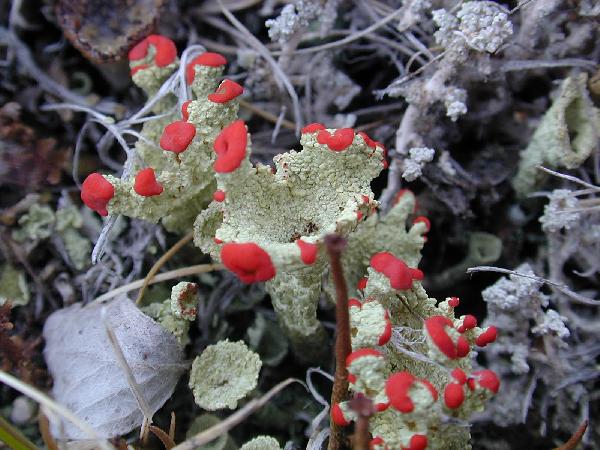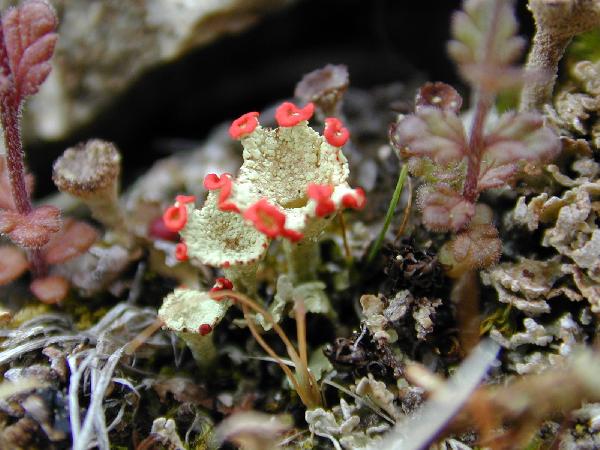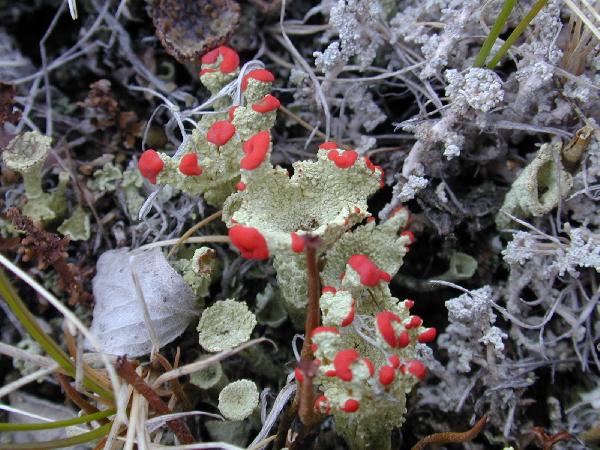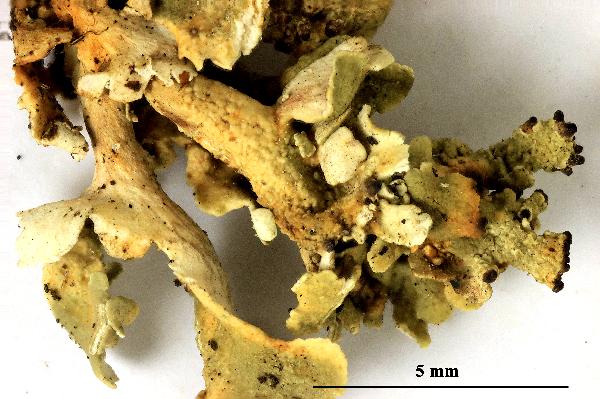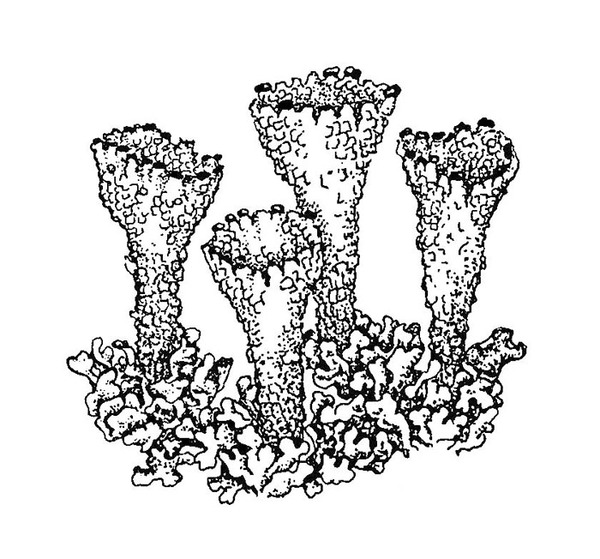Cladonia borealis S. Stenroos
Ann. Bot. Fenn., 26: 160, 1989.
Synonyms:
Distribution: N - Frl, Ven (Nascimbene & Caniglia 2000, 2003c), TAA (Bilovitz & al. 2014, Nascimbene 2014, Nascimbene & Marini 2015, Trindade & al. 2021, Nascimbene & al. 2022), Lomb (Nascimbene 2006), Piem (Burgaz & al. 2020).
Description: Primary thallus squamulose, the squamules middle-sized, 2-4(-5) mm long, 2-3 mm wide, variable in form, rounded or a little indented, white or often yellowish towards the base beneath. Podetia goblet-shaped, hollow inside, yellowish-green, continuously corticate in lower part, areolate in upper part, esorediate, non- or scarcely squamulose, 1-2(-3) cm tall, bearing 6-12 mm wide, regular cups flaring into a short stalk, the inner part of cups areolate, the areoles forming 0.2-0.8 flattened plates (schizidia). Apothecia frequent, scarlet red, convex, developing along the margins of cups, often coalescent into c. 3 mm wide clusters. Asci 8-spored, clavate, thickened at apex, with a K/I+ blue tholus and a K/I+ strongly blue outer gelatinous sheath, Cladonia-type. Ascospores 1-celled, hyaline, ellipsoid. Pycnidia scarlet red, semi-immersed, pyriform. Conidia hyaline, curved. Photobiont chlorococcoid. Spot tests: K-, C-, KC+ yellow, P-, UV-. Chemistry: usnic, barbatic and 4-O-demethylbarbatic acids; rhodocladonic acid in apothecia and pycnidia.Note: on acid, mineral siliceous soil in open habitats near or above treeline; related to C. coccifera and with a similar ecology, and certainly more widespread in the Alps.
Growth form: Fruticose
Substrata: soil, terricolous mosses, and plant debris
Photobiont: green algae other than Trentepohlia
Reproductive strategy: mainly asexual, by soredia, or soredia-like structures (e.g. blastidia)
Commonnes-rarity: (info)
Alpine belt: very rare
Subalpine belt: rare
Oromediterranean belt: absent
Montane belt: extremely rare
Submediterranean belt: absent
Padanian area: absent
Humid submediterranean belt: absent
Humid mediterranean belt: absent
Dry mediterranean belt: absent

Predictive model
Herbarium samples
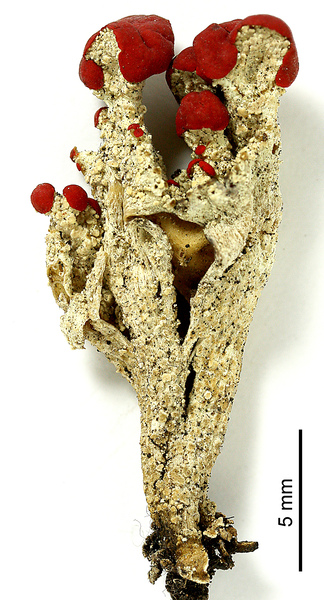

Felix Schumm – CC BY-SA 4.0
[11844], Norwegen, Troms, Senja Island, Ånderdalen National Park,open birch-pine woodland around Åndervatnet, on mossy primary rocks and raw humus, c. 100 m, Leg. et det. G. Follmann & M. Schulz 09.1992. Follmann: Lich. Exs. Sel. 527
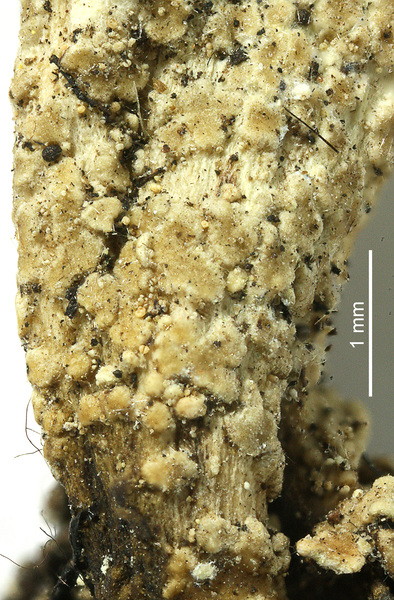

Felix Schumm – CC BY-SA 4.0
[11844], Norwegen, Troms, Senja Island, Ånderdalen National Park,open birch-pine woodland around Åndervatnet, on mossy primary rocks and raw humus, c. 100 m, Leg. et det. G. Follmann & M. Schulz 09.1992. Follmann: Lich. Exs. Sel. 527
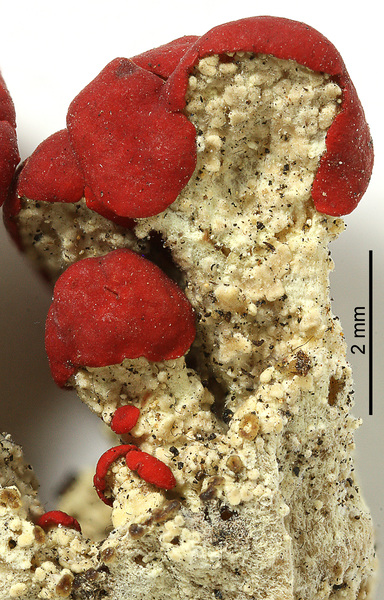

Felix Schumm – CC BY-SA 4.0
[11844], Norwegen, Troms, Senja Island, Ånderdalen National Park,open birch-pine woodland around Åndervatnet, on mossy primary rocks and raw humus, c. 100 m, Leg. et det. G. Follmann & M. Schulz 09.1992. Follmann: Lich. Exs. Sel. 527
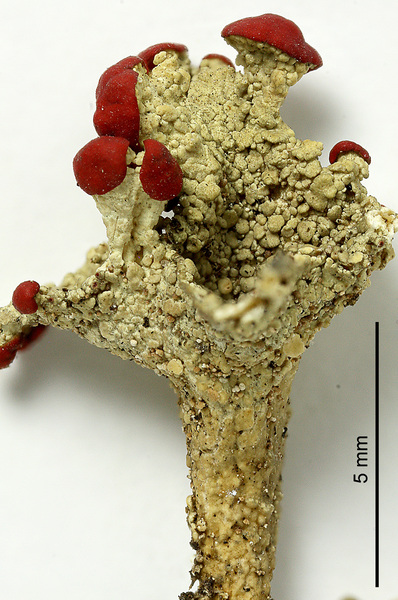

Felix Schumm – CC BY-SA 4.0
[11844], Norwegen, Troms, Senja Island, Ånderdalen National Park,open birch-pine woodland around Åndervatnet, on mossy primary rocks and raw humus, c. 100 m, Leg. et det. G. Follmann & M. Schulz 09.1992. Follmann: Lich. Exs. Sel. 527


Felix Schumm – CC BY-SA 4.0
[11844], Norwegen, Troms, Senja Island, Ånderdalen National Park,open birch-pine woodland around Åndervatnet, on mossy primary rocks and raw humus, c. 100 m, Leg. et det. G. Follmann & M. Schulz 09.1992. Follmann: Lich. Exs. Sel. 527,
HPTLC in den Laufmitteln A, B’ und C nach Säurebehandlung bei Tageslicht und 366 nm UV-Langwelle. 1: Start, 4: Position von Norstictinsäure, 7: Position von Atranorin, ba = Barbatsäure
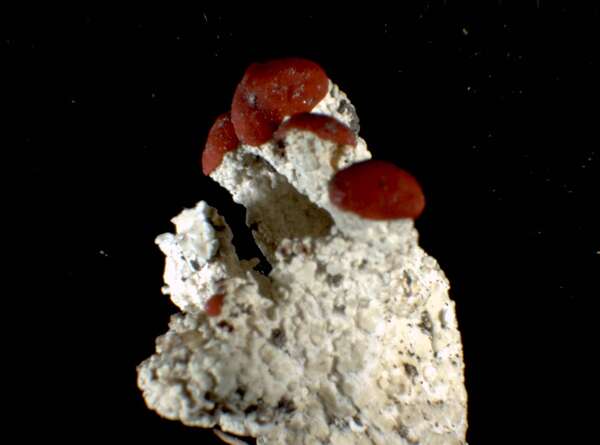

P.L. Nimis; Owner: Department of Life Sciences, University of Trieste
Herbarium: TSB (12926)
2001/12/04
detail of apothecia
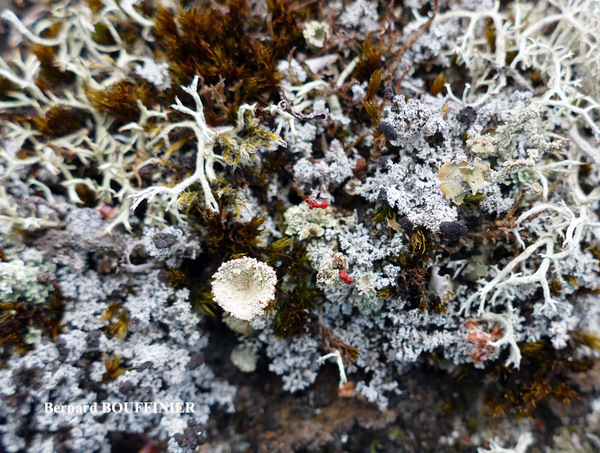
Bernard Bouffinier - Source: http://www.lichensmaritimes.org/index.php?task=fiche&lichen=1180&lang=en
Sweden, Slado-Askeskars

Bernard Bouffinier - Source: http://www.lichensmaritimes.org/index.php?task=fiche&lichen=1180&lang=en
Sweden, Slado-Askeskars

Bernard Bouffinier - Source: http://www.lichensmaritimes.org/index.php?task=fiche&lichen=1180&lang=en
Sweden, Slado-Askeskars

Saxifraga-Willem van Kruijsbergen http://www.freenatureimages.eu/plants/Lichenes,%20Korstmossen,%20Lichens/Cladonia%20borealis,%20Boreal%20cup%20lichen/
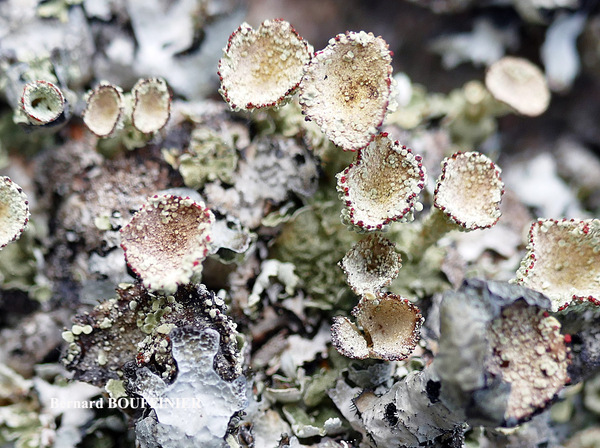
Bernard Bouffinier - Source: http://www.lichensmaritimes.org/index.php?task=fiche&lichen=1180&lang=en
Sweden, Slado-Askeskars
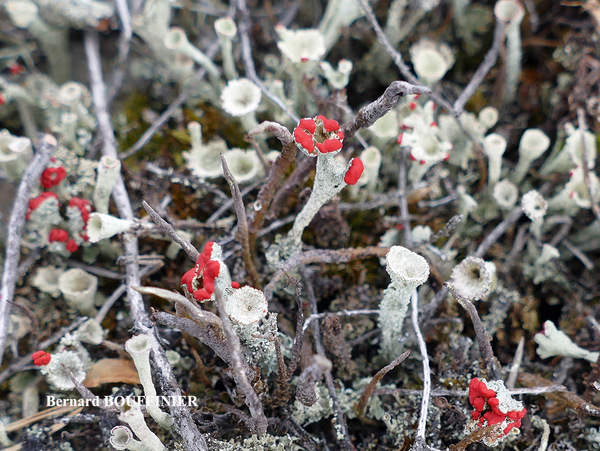
Bernard Bouffinier - Source: http://www.lichensmaritimes.org/index.php?task=fiche&lichen=1180&lang=en
Sweden, Iles de Vastervik
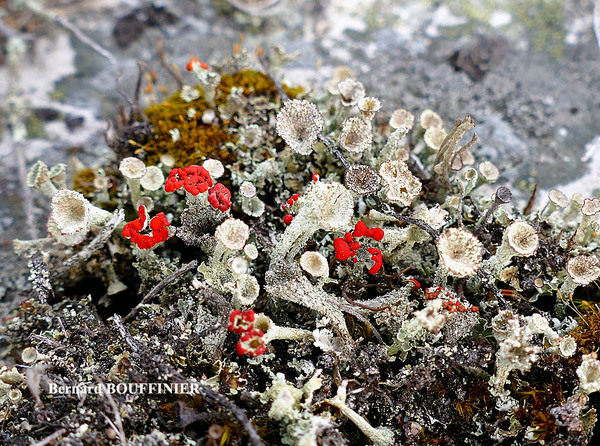
Bernard Bouffinier - Source: http://www.lichensmaritimes.org/index.php?task=fiche&lichen=1180&lang=en
Sweden, Iles de Vastervik
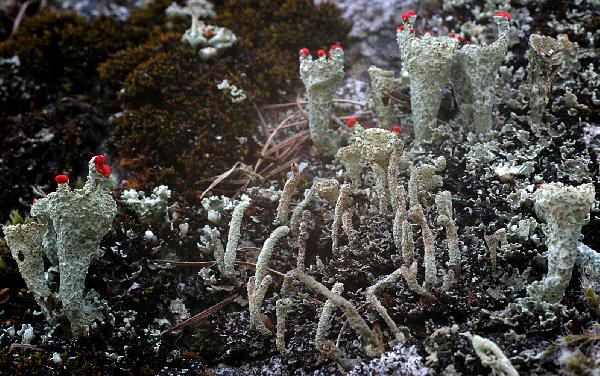
Ulrich Kirschbaum CC BY-SA 4.0 - Source: https://www.thm.de/lse/ulrich-kirschbaum/flechtenbilder
Sweden; Värmland.
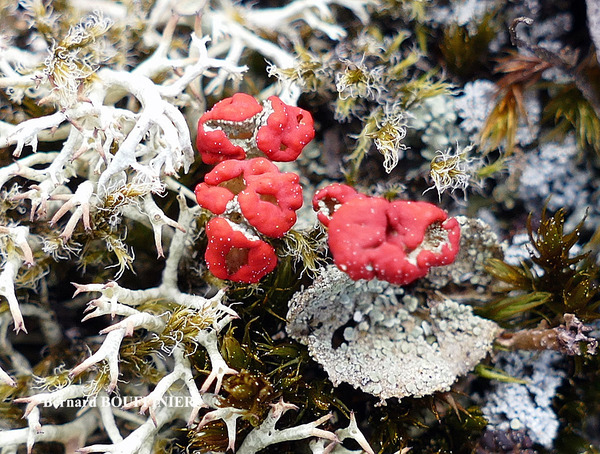
Bernard Bouffinier - Source: http://www.lichensmaritimes.org/index.php?task=fiche&lichen=1180&lang=en
Sweden, Slado-Askeskars
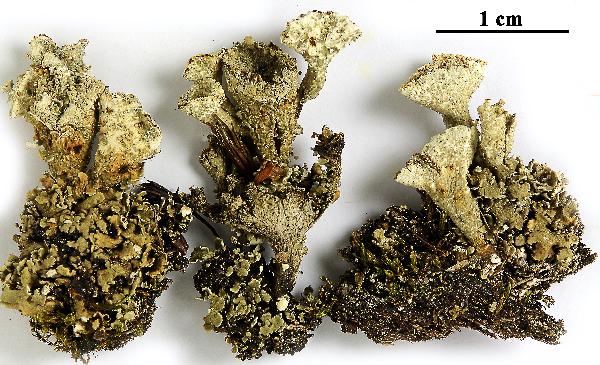

Felix Schumm - CC BY-SA 4.0
[VZR478, 19837], Hollandia, Brabantia borealis, loco "Gastelsche
Heide" dicto, Callunetum in margine silvae (Pinus), ad terram. Leg. P.
v. d. Boom (27948), 22.09.2001, det. P. v. d. Boom. EX A. VEZDA: LICHENES
RARIORES EXSICCATI NR. 478.
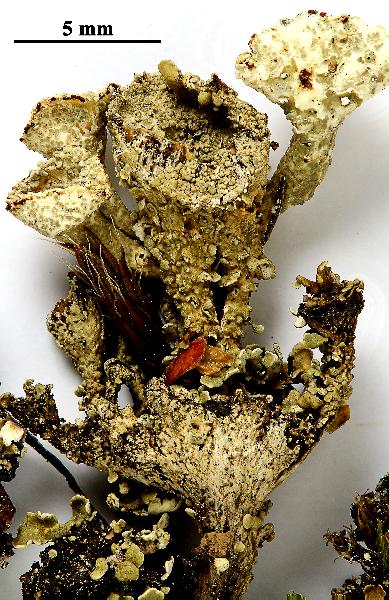

Felix Schumm - CC BY-SA 4.0
[VZR478, 19837], Hollandia, Brabantia borealis, loco "Gastelsche
Heide" dicto, Callunetum in margine silvae (Pinus), ad terram. Leg. P.
v. d. Boom (27948), 22.09.2001, det. P. v. d. Boom. EX A. VEZDA: LICHENES
RARIORES EXSICCATI NR. 478.
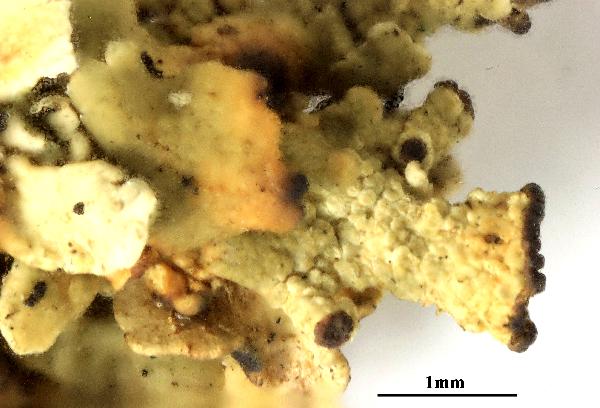

Felix Schumm - CC BY-SA 4.0
[VZR478, 19837], Hollandia, Brabantia borealis, loco "Gastelsche
Heide" dicto, Callunetum in margine silvae (Pinus), ad terram. Leg. P.
v. d. Boom (27948), 22.09.2001, det. P. v. d. Boom. EX A. VEZDA: LICHENES
RARIORES EXSICCATI NR. 478.
Growth form: Fruticose
Substrata: soil, terricolous mosses, and plant debris
Photobiont: green algae other than Trentepohlia
Reproductive strategy: mainly asexual, by soredia, or soredia-like structures (e.g. blastidia)
Commonnes-rarity: (info)
Alpine belt: very rare
Subalpine belt: rare
Oromediterranean belt: absent
Montane belt: extremely rare
Submediterranean belt: absent
Padanian area: absent
Humid submediterranean belt: absent
Humid mediterranean belt: absent
Dry mediterranean belt: absent

Predictive model
| Herbarium samples |


Felix Schumm – CC BY-SA 4.0
[11844], Norwegen, Troms, Senja Island, Ånderdalen National Park,open birch-pine woodland around Åndervatnet, on mossy primary rocks and raw humus, c. 100 m, Leg. et det. G. Follmann & M. Schulz 09.1992. Follmann: Lich. Exs. Sel. 527


Felix Schumm – CC BY-SA 4.0
[11844], Norwegen, Troms, Senja Island, Ånderdalen National Park,open birch-pine woodland around Åndervatnet, on mossy primary rocks and raw humus, c. 100 m, Leg. et det. G. Follmann & M. Schulz 09.1992. Follmann: Lich. Exs. Sel. 527


Felix Schumm – CC BY-SA 4.0
[11844], Norwegen, Troms, Senja Island, Ånderdalen National Park,open birch-pine woodland around Åndervatnet, on mossy primary rocks and raw humus, c. 100 m, Leg. et det. G. Follmann & M. Schulz 09.1992. Follmann: Lich. Exs. Sel. 527


Felix Schumm – CC BY-SA 4.0
[11844], Norwegen, Troms, Senja Island, Ånderdalen National Park,open birch-pine woodland around Åndervatnet, on mossy primary rocks and raw humus, c. 100 m, Leg. et det. G. Follmann & M. Schulz 09.1992. Follmann: Lich. Exs. Sel. 527


Felix Schumm – CC BY-SA 4.0
[11844], Norwegen, Troms, Senja Island, Ånderdalen National Park,open birch-pine woodland around Åndervatnet, on mossy primary rocks and raw humus, c. 100 m, Leg. et det. G. Follmann & M. Schulz 09.1992. Follmann: Lich. Exs. Sel. 527,
HPTLC in den Laufmitteln A, B’ und C nach Säurebehandlung bei Tageslicht und 366 nm UV-Langwelle. 1: Start, 4: Position von Norstictinsäure, 7: Position von Atranorin, ba = Barbatsäure


P.L. Nimis; Owner: Department of Life Sciences, University of Trieste
Herbarium: TSB (12926)
2001/12/04
detail of apothecia

Bernard Bouffinier - Source: http://www.lichensmaritimes.org/index.php?task=fiche&lichen=1180&lang=en
Sweden, Slado-Askeskars

Bernard Bouffinier - Source: http://www.lichensmaritimes.org/index.php?task=fiche&lichen=1180&lang=en
Sweden, Slado-Askeskars

Bernard Bouffinier - Source: http://www.lichensmaritimes.org/index.php?task=fiche&lichen=1180&lang=en
Sweden, Slado-Askeskars

Saxifraga-Willem van Kruijsbergen http://www.freenatureimages.eu/plants/Lichenes,%20Korstmossen,%20Lichens/Cladonia%20borealis,%20Boreal%20cup%20lichen/

Bernard Bouffinier - Source: http://www.lichensmaritimes.org/index.php?task=fiche&lichen=1180&lang=en
Sweden, Slado-Askeskars

Bernard Bouffinier - Source: http://www.lichensmaritimes.org/index.php?task=fiche&lichen=1180&lang=en
Sweden, Iles de Vastervik

Bernard Bouffinier - Source: http://www.lichensmaritimes.org/index.php?task=fiche&lichen=1180&lang=en
Sweden, Iles de Vastervik

Ulrich Kirschbaum CC BY-SA 4.0 - Source: https://www.thm.de/lse/ulrich-kirschbaum/flechtenbilder
Sweden; Värmland.

Bernard Bouffinier - Source: http://www.lichensmaritimes.org/index.php?task=fiche&lichen=1180&lang=en
Sweden, Slado-Askeskars


Felix Schumm - CC BY-SA 4.0
[VZR478, 19837], Hollandia, Brabantia borealis, loco "Gastelsche Heide" dicto, Callunetum in margine silvae (Pinus), ad terram. Leg. P. v. d. Boom (27948), 22.09.2001, det. P. v. d. Boom. EX A. VEZDA: LICHENES RARIORES EXSICCATI NR. 478.


Felix Schumm - CC BY-SA 4.0
[VZR478, 19837], Hollandia, Brabantia borealis, loco "Gastelsche Heide" dicto, Callunetum in margine silvae (Pinus), ad terram. Leg. P. v. d. Boom (27948), 22.09.2001, det. P. v. d. Boom. EX A. VEZDA: LICHENES RARIORES EXSICCATI NR. 478.


 INDEX FUNGORUM
INDEX FUNGORUM
 GBIF
GBIF
 DOLICHENS
DOLICHENS
